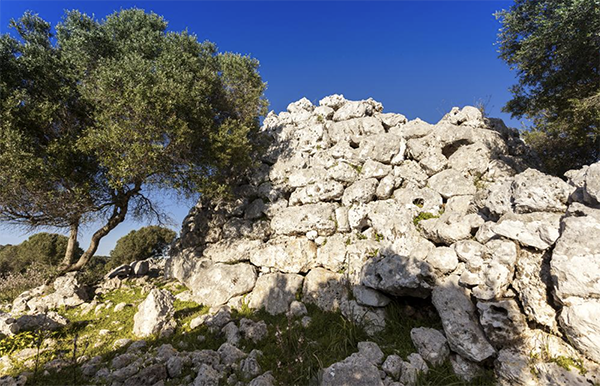Talayotic settlement of Sant Agustí Vell (Es Migjorn Gran).
Location:Talayotic settlement of Sant Agustí Vell (Es Migjorn Gran)
Project managers:
Team:
Montserrat Anglada
Ismael Moll
Dr. Damià Ramis
- Radiocarbon dating: Dr. Mark Van Strydonck and Dr. Mathieu Bodin Sedimentology: Dr. Carlos Verdasco
- Carpology: Dr. Guillem PÉREZ JORDÀ
- Physical anthropology: Elena Sintes
- Palynology: Gabriel Servera
- Phytoliths and Microarchaeology: Mónica ALONSO EGUILUZ Anthracology: Dr. Llorenç PICORNELL
- Indigenous pottery typology: Dr. Lluís PLANTALAMOR
- Imported pottery typology: Dr. Jordi HERNÁNDEZ GASCH
- Malacology: Dr. Guillem Xavier PONS
- Zooarchaeology: Dr. Damià Ramis
- Planimetric mapping: Dr. Lluís PLANTALAMOR
- Photogrammetry and 3D mapping: Dr. Nicolau Escanilla
- Restoration-Conservation: Montserrat Anglada
- Geology: Dr. Francesc Xavier ROIG
- Metallurgical studies and Topography: Dr. Nicolau Escanilla
Scientific objectives:Studies carried out on talayots have not yet achieved a conclusive explanation regarding the various uses with which they have been attributed. The limited interventions executed in Menorca on this type of structure have led to the conclusion that these were buildings of a communal nature whose purposes may have included monitoring, observation, communication and consideration as a symbolic element that unified the communities that built them. In this sense, the typological variety visible in Menorcan talayots further complicates their interpretation, and the talayot 1 of Sant Agustí is no exception. Within this typological variety, talayot 1 corresponds to those with an inner chamber, which is not usual in Menorcan talayots. Another peculiarity is that it still shows its original wild olive wooden beams in an exceptional state of conservation. On the other hand, the talayot is surrounded by a series of ajacent structures radially arranged. It is worth highlighting a rectangular construction attached to the southern side of the talayot, which has a certain resemblance to the southern building of Cornia Nou settlement. It has been brought to light that the Cornia Nou construction was part of a monumental complex used during the first half of the first millennium BC, approximately.

The main goal of the project is, based on the architectural complex that is to be analyzed in Sant Agustí, to obtain new data that provides and contrasts the existing information about this type of adjacent structures and buildings. Therefore, it is all about obtaining new data on the architecture and periods of use and abandonment, which will allow us to establish temporary connections and possible complementary links between these structures.
The results of the excavation obtained from the analysis and specialized studies derived from the project will be integrated into general social and economic models as well as paleoenvironmental, to advance in the knowledge of the Talayotic culture.
Results obtained:In the first three excavation campaigns, the perimeter of the southern building has been precisely delimited, both inside and outside. During the last archaeological campaign, the excavation of the southern building corridor that leads to the portal of the eastern talayot was completed. In the absence of more precise dates, it can be said that the corridor was abandoned around the II BC. Still, one can speak of various reoccupations of the structures and exteriors, at least until medieval Islamic times. We work with the photogrammetric model of the complex to obtain precise and detailed information about the archaeological site.
The materials recovered have made it possible to document ceramics, remains of fauna and lithic industry, which are in the process of study. Among these materials, we must highlight the presence of cereal seeds from the interior corridor of the southern building.
Related articles:
- Anglada, M.; Ferrer, A.; Moll, I.; Picornell, Ll.; Ramis, D.; Riudavets, I.; Ruiz, R.; Van Strydonck, M. (in press) «The wooden beams of Sant Agusti’s talayot ??1 (Menorca): taxonomic identification and radiocarbon dating». A: Ferrer, A.; Alarcón, E.: Congress of Prehistory and Protohistory of the Mediterranean (Life and death during the second and first millennium BC). Consell Insular de Menorca, Maó.
- Moll, I.; Anglada, M.; Ramis, D. (2017) «Sant Agustí Vell, new archaeological project». Àmbit. Culture Magazine, 46. Department of Cultural Affairs and Education, Consell Insular de Menorca.
- Ramis, D.; Moll, I.; Anglada, M. (2019) «Sant Agustí Vell, Es Migjorn Gran». Àmbit. Culture Magazine, 53. Department of Cultural Affairs and Education, Consell Insular de Menorca.
- Anglada, M.; Ramis, D.; Moll, I. (2020) «Advances in Sant Agustí Vell excavations». Àmbit. Culture Magazine, 63. Department of Cultural Affairs and Education, Consell Insular de Menorca.
Supporting entities:Associació Arqueologia i Patrimoni
Associates:
Consell Insular de Menorca, Ajuntament des Migjorn Gran